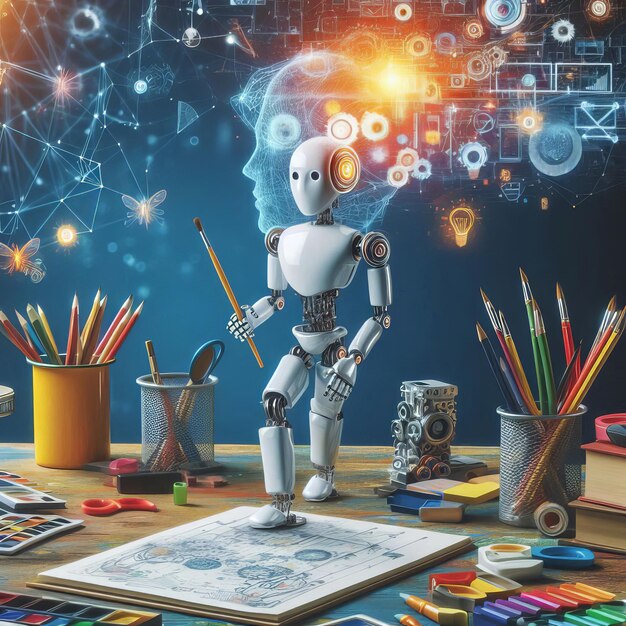Quick Read
Revolutionizing Homework: Generative AI in English Classes
revolutionizing
the educational landscape, particularly in English classes, by offering
innovative
and
engaging
ways to approach traditional
homework assignments
. By harnessing the power of AI, teachers can design personalized and adaptive tasks that cater to each student’s unique learning needs. The result is a more effective, efficient, and enjoyable homework experience for both students and teachers.
Personalized Learning
One of the most significant advantages of using
Adaptive Tasks
Moreover, generative AI can create adaptive tasks that adjust in real-time based on students’ responses. This feature allows teachers to assess each student’s understanding and adjust the difficulty level of tasks accordingly, ensuring that they remain engaged and challenged throughout the learning process. For instance, an AI-powered writing tool can analyze a student’s writing style and provide suggestions for improving grammar, syntax, and coherence in real-time.
Improving Teacher Efficiency
Generative ai also offers significant time-saving benefits for teachers. By automating the process of grading and providing instant feedback, teachers can focus on more critical aspects of teaching and student engagement. Additionally, ai-generated tasks can be easily customized for various class levels and sizes, further saving teachers’ time in creating and distributing traditional homework assignments.
Engaging Students
Lastly, the use of generative ai in English classes can help increase students’ engagement and motivation. By providing personalized, adaptive, and interactive homework tasks, teachers can make learning a more enjoyable experience for their students. Furthermore, ai-generated tasks can be designed to incorporate various multimedia elements, such as videos, images, and interactive quizzes, making the homework process more dynamic and engaging.

Transforming Homework with Generative AI
Homework, a fundamental part of the educational process, has long been a source of contention among students, teachers, and parents alike. Traditionally, homework is assigned by teachers, collected during class sessions, graded, and then returned to students for their review. This process consists of three main stages: assigning, collecting, and grading assignments. However, this time-consuming and often ineffective process leaves many students disengaged, leading to a lack of motivation and learning.
Brief Overview of the Traditional Homework Process
The traditional homework process can be broken down into three stages:
Assigning:
Teachers assign homework with the intention of reinforcing concepts learned in class, providing practice, and encouraging independent study. However, with a large classroom size and diverse student population, teachers often struggle to assign homework that is both meaningful and relevant for each student.
Collecting:
Collecting homework can be a time-consuming task for teachers, especially when dealing with a large class size. Students must turn in their assignments during designated times, often causing disruptions to the classroom flow.
Grading:
The grading process can be lengthy and time-consuming, particularly for teachers with large classes or complex assignments. Grading also requires a high level of attention to detail and consistency to ensure fairness and accuracy.
Introduction to Generative AI and Its Potential in Education
Enter Generative AI, a subfield of artificial intelligence that focuses on creating new content, such as text, images, and music. With its ability to generate unique content based on input data, Generative AI offers numerous applications in various fields, including education.
Definition and Capabilities:
Generative AI models use complex algorithms to learn patterns from input data, enabling them to generate new content that closely resembles the original data. These models can be trained on vast amounts of data and refined through iterative processes to improve their accuracy and creativity.
Applications in Education:
In education, Generative AI can be employed to create personalized learning content for students based on their individual learning styles and progress. This adaptive approach allows teachers to tailor instruction to each student’s needs, fostering a more engaging and effective learning experience. Additionally, Generative AI can be used to assess students’ understanding of complex concepts by analyzing their responses to open-ended questions or generating follow-up questions based on incorrect answers. This not only saves time for teachers but also provides more accurate and detailed feedback for students, ultimately improving learning outcomes.
Benefits of Using Generative AI for Homework in English Classes
Personalized Learning Experience
Generative AI can provide a personalized learning experience tailored to each student’s skill level and learning style. By analyzing individual performance data, AI can adapt assignments to better suit each student’s needs. This personalized approach not only leads to improved academic performance, but also contributes to a more engaging and effective learning experience.
Enhanced Engagement and Motivation
Moreover, generative AI can enhance engagement and motivation in students through interactive assignments that cater to diverse interests. AI-driven educational platforms can offer a wide range of topics, allowing students to explore new ideas and expand their knowledge base. By encouraging creativity and exploration, AI can help students develop a deeper interest in learning.
Time-Saving for Educators
From an educator’s perspective, generative AI can be a valuable tool in streamlining administrative tasks. With automated grading and assessment, teachers save time and resources that can be reallocated to more meaningful activities, such as instruction and student interaction. Moreover, AI can help reduce the overall administrative burden, allowing educators to focus on their core responsibilities: teaching and guiding students.
Real-life Application of Technology Skills
Finally, integrating generative AI into homework assignments provides an excellent opportunity for students to develop essential 21st-century skills
such as digital literacy, creativity, and problem-solving abilities. By learning to engage with AI in a productive and meaningful way, students are better prepared to thrive in an increasingly digital world.

I Implementation of Generative AI in English Classes for Homework
Designing effective prompts and tasks:
- Creativity and open-endedness: Generative AI can be used to create unique and imaginative prompts for students, fostering a creative learning environment. This could include writing prompts, essay topics, or even poetry prompts that challenge students to think outside the box.
- Encouraging critical thinking and problem-solving skills: Generative AI can also be used to present students with complex tasks that require analysis, synthesis, and evaluation. For example, it could generate a news article with missing information and ask students to fill in the blanks using critical thinking skills.
Ensuring the ethical use of generative AI in education:
- Addressing plagiarism concerns: One of the biggest concerns with using generative AI in education is the potential for plagiarism. However, this can be addressed by ensuring that students are aware of the technology and the importance of originality. Additionally, AI-generated content can be checked for plagiarism using tools designed for this purpose.
- Encouraging originality and student ownership of work: It’s important to remind students that AI is a tool to assist them, not replace their own creativity and critical thinking skills. Encouraging originality and student ownership of work can be done by setting clear expectations and providing guidance on how to use AI in an ethical manner.
Integrating generative AI with existing learning platforms:
- Seamless integration for a more efficient workflow: Generative AI can be integrated with existing learning platforms to streamline the homework process and save teachers time. For example, it could generate personalized prompts based on student data or automatically grade assignments using AI.
- Enhancing the overall user experience: Integrating generative AI with learning platforms can also improve the overall user experience for students. For example, it could provide instant feedback on assignments or suggest additional resources based on student performance.
Encouraging teacher involvement and oversight:
- Monitoring AI-generated assignments for accuracy and appropriateness: Teachers should monitor AI-generated assignments to ensure that they are accurate, appropriate, and align with learning objectives. This can be done through a review process or using automated tools to check for errors.
- Providing guidance, feedback, and support to students: Finally, teachers should be involved in the process of using generative AI in the classroom. This could include providing guidance on how to use the technology effectively, offering feedback on assignments, and supporting students as they learn to navigate this new tool.

Real-world Examples of Generative AI in English Education
Generative AI, a subset of artificial intelligence (AI) that can create new content, is increasingly being used in the field of English education to enhance teaching and learning experiences. In this section, we will explore some case studies of successful implementations, highlighting the process, outcomes, and benefits of using generative AI in English education.
Case Study: Duolingo’s AI-Powered Language Tutor
Duolingo, a popular language learning platform, uses AI to create personalized lessons for its users. The AI system analyzes users’ performance and adapts the learning material accordingly. The outcome is a more effective and engaging learning experience. One of the key benefits is that students can learn at their own pace, making English education more accessible to a wider audience.
Best Practices and Lessons Learned
Best Practices for Successful Integration:
Collaborate with experts: Partnering with AI developers and educational institutions can help create effective and engaging AI-powered learning tools.
Prioritize user experience: Make sure the AI integration enhances, rather than distracts from, the learning process.
Ensure accessibility and inclusivity: Design the AI system to be accessible to students with different learning styles and abilities.
Challenges Faced and Potential Solutions:
Data privacy concerns: Develop a clear data privacy policy to address students’ concerns about the collection, storage, and use of their personal information.
Ethical considerations: Address potential ethical issues, such as AI-generated content that could be offensive or inappropriate, through rigorous testing and oversight.
Case Study: Carnegie Mellon University’s ESL Program
Carnegie Mellon University’s English as a Second Language (ESL) program uses AI to create personalized learning plans for each student. The system analyzes students’ language proficiency levels, learning styles, and interests to design customized lesson plans. This results in more effective and engaging English education for non-native speakers.
Best Practices and Lessons Learned
Best Practices for Successful Integration:
Foster a growth mindset: Encourage students to embrace the learning process and view mistakes as opportunities for growth.
Provide ongoing feedback: Regularly assess students’ progress and provide constructive feedback to help them improve.
Foster collaboration: Encourage students to learn from each other, both online and offline, through peer-to-peer interactions facilitated by AI.
Challenges Faced and Potential Solutions:
Limited resources: Develop strategies to allocate resources effectively, such as partnering with local organizations or leveraging open-source AI tools.
Addressing cultural differences: Ensure that the AI system is sensitive to different cultural backgrounds and adapts to diverse learning styles.

Conclusion
In this article, we have explored the promising potential of generative AI in education. This innovative approach offers numerous benefits for both students and educators. For students, it provides a more personalized learning experience through adaptive instruction, instant feedback, and engaging content creation. On the other hand, educators can save time and resources by automating administrative tasks and gaining valuable insights into student learning patterns.
Recap of Benefits, Implementation, and Real-World Examples
Generative AI can benefit various aspects of education, such as language learning, math tutoring, and even art instruction. For instance, Duolingo, a popular language learning platform, uses generative AI algorithms to create personalized exercises based on each student’s progress. Similarly, Carnegie Mellon University‘s Alice Project employs generative AI to help students create interactive stories, games, and animations.
Encouragement for Educators to Explore Generative AI
As we have seen, generative AI is a powerful tool that can enhance the learning experience for students. However, it’s essential to remember that this technology should not replace human teachers but rather augment their abilities. Therefore, we encourage educators to explore this innovative approach with an open mind and consider how it can be integrated into their classrooms to create a more engaging, efficient, and personalized learning environment.
Call to Action for Further Research and Collaboration
The field of generative AI in education is still in its infancy, and there’s much to be discovered. We call for further research in this area, particularly focusing on the ethical implications, accessibility, and scalability of these technologies. By collaborating with researchers, developers, and educators, we can ensure that generative AI is used responsibly and effectively to enhance the educational experience for all learners.
Join the Conversation
Do you have any experiences or insights to share about using generative AI in education? Please leave a comment below and join the conversation. Together, we can help shape the future of this exciting technology in the field of education.
